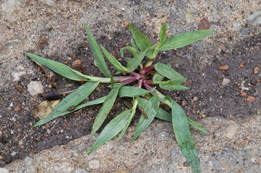 This is the time of year when people really notice crabgrass infestations. By far the best way to control crabgrass is to prevent it by maintaining a good, thick lawn. Crabgrass is an annual that must come up from seed each year and the seed must have light in order to germinate. If a lawn is thick enough that sunlight does not reach the soil, the crabgrass will not germinate. Under Kansas conditions it is not easy to maintain such a lawn; so many gardeners do the next best thing and apply a crabgrass preventer in the spring. Crabgrass preventers kill the seed as it germinates. Most do not have any effect on crabgrass that has already come up. If we are too late to apply a preventer, we do have other herbicides that will kill crabgrass after it is up including Ortho Weed-B-Gon Max +Crabgrass Control, Fertilome Weed-Out with Crabgrass Control and Bayer Lawn Weed & Crabgrass Killer. Each contains quinclorac, which is a crabgrass herbicide, as well as other active ingredients that control broadleaf weeds. We also have a homeowner formulation of quinclorac under the trade name of Drive that is available from Monterey Lawn and Garden. Quiclorac is an excellent crabgrass killer that controls not only crabgrass but also has good activity on foxtail and certain broadleaves such as field bindweed, black medic and clover. However, it does little to nothing to goosegrass. Fortunately, crabgrass starts declining about the middle of August. This is about the same time that cool- season grasses such as tall fescue and Kentucky bluegrass start to come out of their summer doldrums. By the first of September, the crabgrass will be less noticeable. Therefore, a small infestation is best ignored. Remember that crabgrass is a warm-season annual and will be killed by the first frost. (Ward Upham) 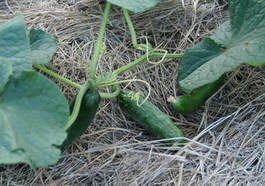 A bitter taste in cucumbers is the result of stress that can be caused by a number of factors, including heredity, moisture, temperature, soil characteristics, and disease. Most often this occurs during the hot part of the summer or later in the growing season. Two compounds, cucurbitacins B and C, give rise to the bitter taste. Though often only the stem end is affected, at times the entire fruit is bitter. Also, most of the bitter taste is found in and just under the skin. Removing the stem end and the skin can often help salvage bitter fruit. Bitter fruit is not the result of cucumbers cross-pollinating with squash or melons. These plants cannot cross-pollinate with one another. Often newer varieties are less likely to become bitter than older ones. Proper cultural care is also often helpful. Make sure plants have the following: – Well-drained soil with a pH between 6.0 and 6.5. Plenty of organic matter also helps. – Mulch. Mulch helps conserve moisture and keeps roots cool during hot, dry weather. – Adequate water especially during the fruiting season. – Disease and insect control. (Ward Upham) 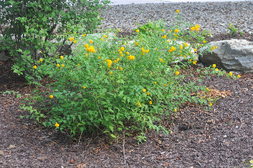 Whenever we have a summer that puts a lot of stress on plants, bloom may appear on ornamentals that normally flower in the spring. This stress is usually caused by hot, dry periods but may be caused by other factors that stress the plant. We have noticed Japanese Kerria blooming now even though it normally blooms in April to May. Don’t be surprised if we see more spring-flowering plants blooming as we progress through the growing season. We have seen lilac, ornamental pears, crabapples and various other plants bloom in the fall in previous years. Fall flowering of plants is normally sparse and does not appreciably affect the amount of bloom the following spring. (Ward Upham) 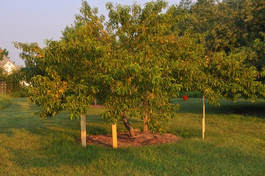 Heavy fruit loads this season may cause limbs to break if they are not given extra support. As fruits increase in size, the additional weight on individual branches may be substantial. One-inch thick boards can be used to prop up limbs. Here's how. Cut a "V" on the top edge of the board on which the limb will rest so that it doesn't slip off. Long limbs that are heavily loaded with fruit may need a prop in the center and another to support the outer part of the limb. A plastic belt-like material that is about 2 inches wide may also be used. This can be tied to a heavily loaded limb, then to a large diameter limb above for support. Where a large limb is used for support, it is good to have it supporting limbs on opposite sides so the weight is balanced. Another solution is to wrap a tape or belt material around the tree in a spiral to prevent limbs from bending until they break. Heavy twine may be used, but it should be removed when the fruit is picked or soon after so it does not cut into the bark on the limb. Check trees regularly, up to two times a week during the last month the fruit are maturing. You will find additional limbs that need support. Tending to the heavily loaded tree limbs will reduce the number of broken limbs and help keep a balance of the fruiting wood in your tree. Next year, prune long, weak branches back to a side branch to help prevent this problem. (Ward Upham) 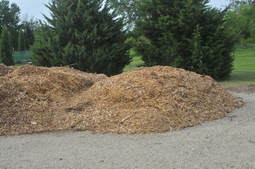 With many municipalities and tree service companies having wood chippers now, gardeners often are able to get chips free. We are sometimes asked our opinion about whether these make a good mulch. Some people have heard that these chips will tie up nitrogen so that the garden plants won't grow as well. If wood chips are used as a mulch, there is no cause for concern. However, if the chips are mixed with the soil, there can be a problem during the breakdown process. The microorganisms that break down the chips need a certain amount of nitrogen during the process. With most green material, there is enough nitrogen in the material itself to meet the needs of the microorganisms. However, nitrogen levels in wood chips are so low, the microorganisms must borrow it from the surrounding soil. This results in less nitrogen being available to the plants. However, when the raw organic material has been digested, the microorganisms die and release the nitrogen. Therefore, the nitrogen is not lost but is simply unavailable for plant use for a period of time. Again, this is only a concern if the wood chips are mixed into the soil. There is no problem with nitrogen tie-up if the chips are used as a mulch. However, one point should be kept in mind. These chips can be used by foraging termites as a bridge to homes and other structures. Termites are light and heat sensitive and will not bother the chips themselves if they are 3 inches deep or less. Therefore, watch the depth of these chips near the house or other buildings. Also leave a bare area several inches wide next to the house so that any termite activity is noticeable. (Ward Upham) 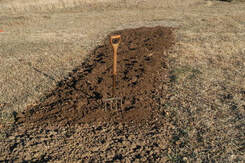 Did you know that increasing your soil's organic matter by 1% has the potential to increase your crop yield by 12%? "Building Better Soil for Better Crops" states that even a small increase in organic matter can have a large positive impact on your crops. How can you increase organic matter? Cover crops, manures, and composts are 3 ways to increase organic matter in your garden. Although these are good strategies, it is important to remember that there can be challenges, so you may need to do some further research. For example, using cover crops requires knowledge, planning, and possibly equipment. Using animal manures is another way to increase organic matter and nutrients for your plants, but there are important things to know before you start. For example, uncomposted manures can harbor human pathogens such as E. coli. Yikes! So manure takes special considerations. The Kansas Garden Guide provides information in the Soil Improvement chapter (https://www.bookstore.ksre.ksu.edu/pubs/s51.pdf). The book "Building Better Soils for Better Crops" has an entire chapter about using manures and if this is something you might be interested in, follow this link, https://bit.ly/2N5Rz35 , to the chapter called "Animal Manures for Increasing Organic Matter and Supplying Nutrients". It has a lot of detail and is geared more for commercial farmers, but some gardeners may be interested in those details. Composting is becoming more and more popular with home gardeners, and starting next week we'll include more details about this practice. For more information about organic matter follow this link, https://bit.ly/2Jbxq9s , to the "Amount of Organic Matter in Soils". (Chandler Day) 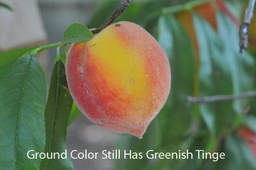 Peaches are best when ripened on the tree but fruit growers may wish to pick a bit early to prevent damage from birds, have a higher pectin content for jams and jellies or to have firmer fruit for canning. Peaches that are mature enough to pick are still hard. They do not give when lightly squeezed. However, these peaches will ripen off the tree and will have very good quality. They may not be quite as sweet as a tree-ripened peach but are still very good. So what do we look for to tell if a peach is mature enough to harvest? Let’s look at a couple of factors. Color: The reddish coloration is not a good indicator. Look instead for what is called the “ground color.” This is the part of the peach that does not turn red; for example, around the stem. The ground color of the peach will lose its greenish tinge and turn yellow when the peach is mature enough to harvest. I use this characteristic more to determine when NOT to pick a peach. If there is any green in the ground color, it is too early. If the ground color is yellow, then I move to the next characteristic. Ease of Removal: A mature peach will separate easily from the branch if the peach is lifted and twisted. If it doesn’t, it is not mature enough to pick yet. All peaches will not be ready to pick at the same time. Pick only those that are ready and come back later for more. It often takes 3 to 5 pickings to harvest a peach tree. Peaches that are picked early but will be used for fresh eating should be allowed to ripen inside at room temperature. Once they are ripe, they can be refrigerated to preserve them for enjoyment over a longer period of time. (Ward Upham) 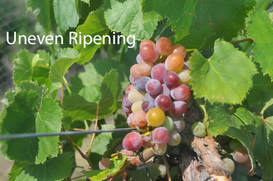 It takes more than color to determine when to harvest grapes. Grapes often are fully colored before they are fully ripe. Look for a whitish coating on the fruit and look for the seeds to change from green to brown. The final test is to taste the berries for sweetness. Grapes don’t continue to ripen once they are removed from the vine so be sure the quality is there before harvesting. We have seen uneven ripening on grapes this year with some berries remaining green while the majority of the cluster being fully ripe. Concord grapes tend to have this problem in most years but other varieties are being affected this year. This is likely due to the excessive heat we have experienced this summer. Once harvested, grapes can be stored for up to eight weeks if kept at 32 degrees with 85 percent relative humidity. Other attractive options are available as well including making juice, jellies, jams and wine. (Ward Upham) |
AuthorsCynthia Domenghini runs the Horticulture Response Center in the Department of Horticulture and Natural Resources at Kansas State University. Other contributors include K-State Extension Specialists. Archives
March 2024
Categories
All
|
| K-State Research and Extension Horticulture Newsletter |
|
 RSS Feed
RSS Feed
